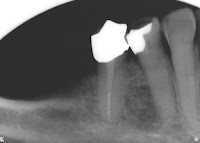Case 50 Implant Vs. Root Canal
 |
| Pre-Operative x-ray #3 |
Tooth number 3 is symptomatic with buccal swelling and an apical lesion is noted. Patient was advised to either have an implant or a root canal. Canals appeared to be sclerosed in the distal buccal and palatal. Options were discussed and patient wanted to save tooth if at all possible.
 |
| Immediate Post-operative x-ray #3 |
All canals were found and obturated with gutta purcha and sealant. There was no separate MB2.
 |
| 6 Month POT x-ray #3 |
Patient is asymptomatic and healing is complete.
Comment: Implants are an option if routine root canal therapy fails and retreatment is not a viable solution. If a tooth is not fractured and all canals are found, root canal therapy is very predictably successful.









